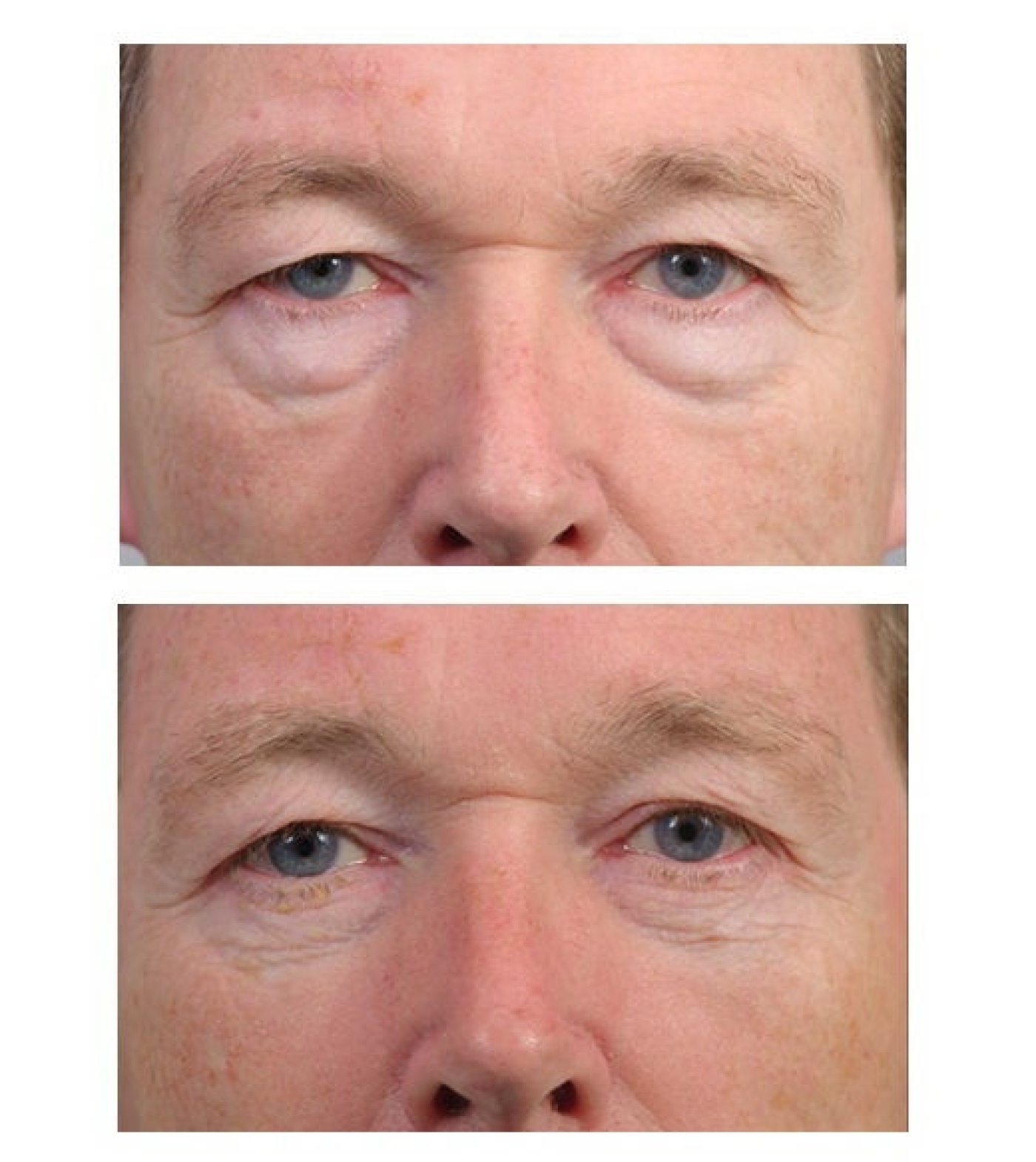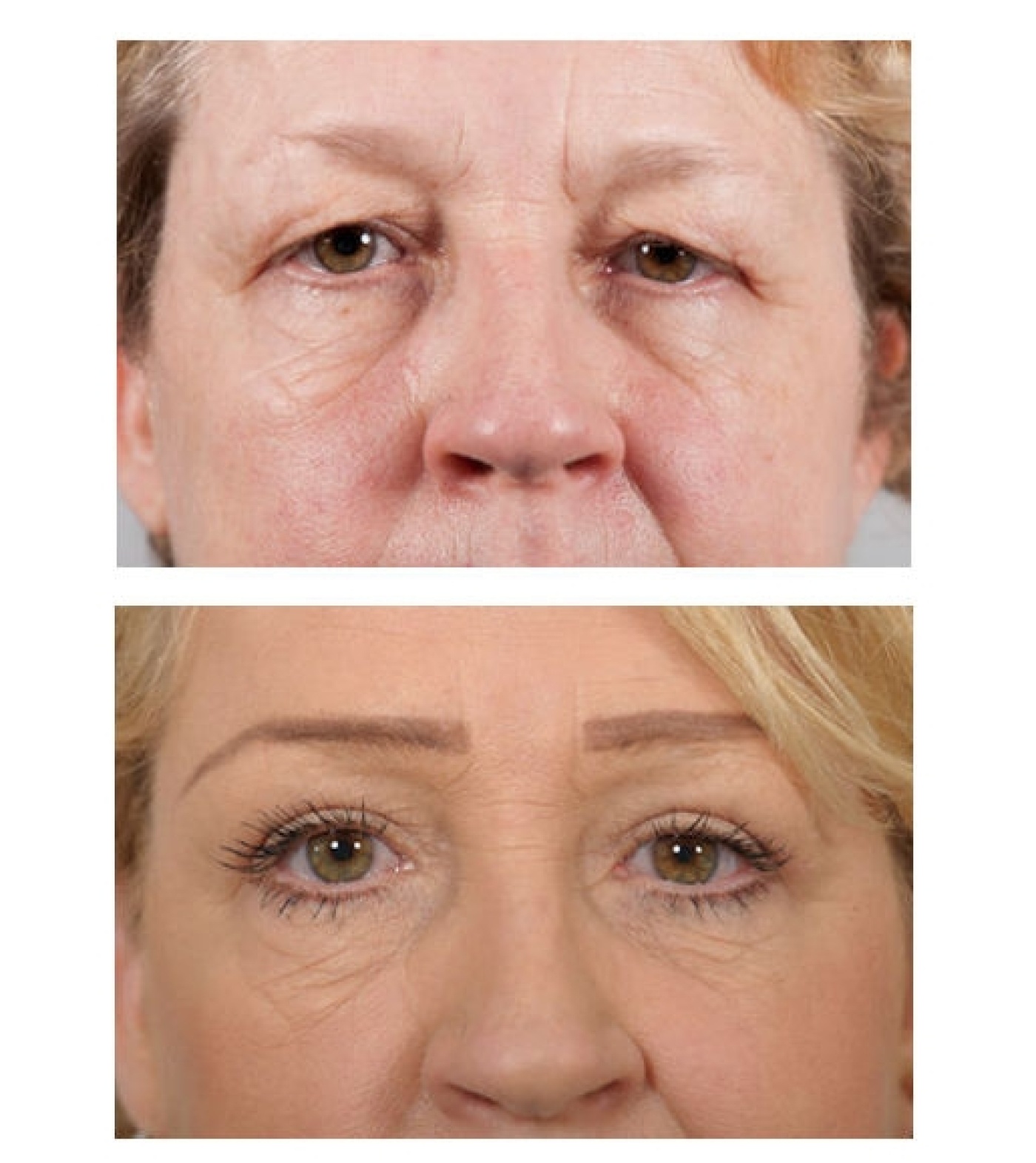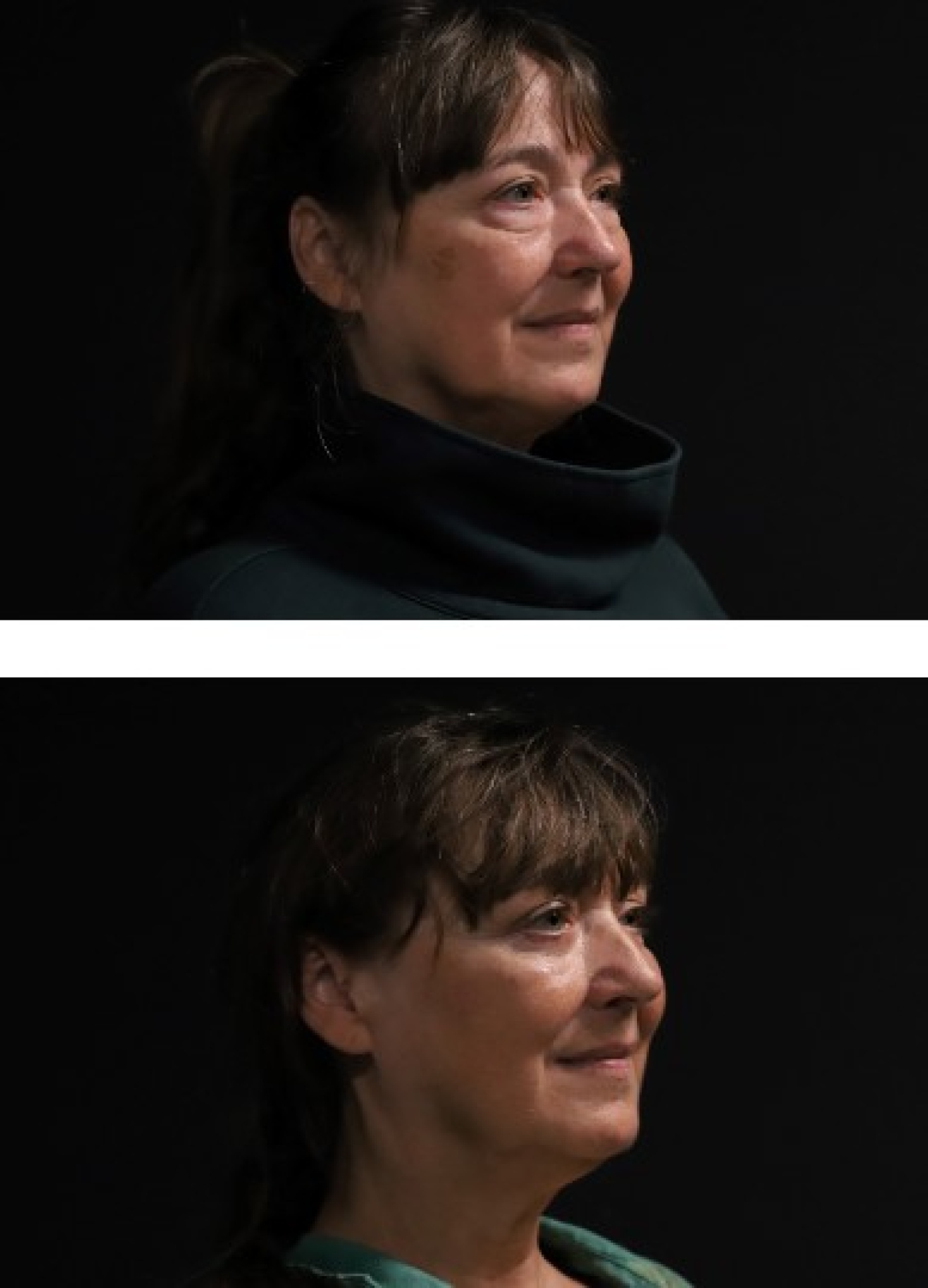Upper and lower eyelid lift
Lower eyelid lifts are my primary expertise. Various contour abnormalities and forms of ageing all require their own surgical technique and approach. The procedure is sensitive to complications, but in experienced hands, the lower eyelid lift is safe.
An upper eyelid lift seems a simple procedure, but that is not always the case. In some cases, the eye muscle must be shortened; in other cases, an eyebrow lift is a better option. Another challenge can be the placement of the scars; these are often placed too high. An expert assessment, good advice and careful performance remain essential.
What is an eyelid lift
Over the years, the skin and the underlying layer of muscle and fat around the eyes may weaken, creating excess upper and lower eyelid skin. This excess shows up as bags and skin folds around the eye, which causes a tired look. Bags are partly congenital and may already be present at a younger age. After a lift procedure, you will look refreshed, which significantly impacts your appearance.
Upper eyelid lift (blepharoplasty)
The excess skin of the upper eyelids is caused by the weakening of the skin as it ages and by the reduction of subcutaneous fat. In some cases, the fat can start swelling, due to the sagging, of the connective tissue this time. An upper eyelid lift is the solution in both cases, removing skin, muscle and/or fat, depending on the indication. The upper eyelid lift provides a fresher look, reduces fatigue, and relieves the pressure on the eyes.
Drooping eyelids are called ptosis; this gives you a somewhat sleepy look. It results from the muscle pulling up the eyelid being too long or overstretched. With these drooping eyelids, the iris, or even the pupil, isn't blocked by the skin but by the eyelid itself. In the latter case, you will see a black rim. Ptosis at an early age is congenital; at a later age, it is often a consequence of (years of) wearing contact lenses. During a ptosis correction, the eyelid muscle is repaired or shortened. See examples of ptosis in these before and after photos of drooping eyelids.
Fatigue, particularly headaches, can be caused by low or drooping eyebrows. During the consultation, it is also essential to look at this. Check out the examples of brow and forehead lift.
Clients often request an eyelid lift, but that is not always the best procedure. As a plastic surgeon with years of experience and expertise in multiple areas, I can advise you on the best treatment.
Lower eyelid lift
A lower eyelid lift usually involves bags under the eyes, caused by the bulging fat around the eye socket. When the light shines from above, you will see dark circles created by the shadow, accentuating the so-called tear trough. The bulging can vary due to air pressure (flying, mountaineering) and fluid retention (salt intake). A lower eyelid lift removes and moves some of this fatty tissue.
In other cases, the bags are the result of excess skin. You can grab the piece of skin, and it forms some folds. In pigmented skin, the excess may also give a dark discolouration caused by pigment accumulation. The skin of the lower eyelids is also very thin, which can cause the dark red colour of the underlying muscle to shine through. In the case of excess skin, only skin is removed during the lower eyelid lift.
Long-term excess skin with creasing of the lower eyelid can cause so-called festoons on the edge of the eye socket. These festoons are difficult to treat. An eyelid lift cannot always remove them completely. In some cases, additional treatment with sclerosing fluid injections is required. Bulky, long-term festoons, usually at an advanced age, can be removed with a (barely) visible scar on the edge of the eye socket. The before and after photographs of eyelid lifts show examples of various (lower) eyelid lifts.
Finally, lower eyelids may also age due to the sagging of the face and (the outside of) the eyebrows. In those cases, the lower eyelid improvement may be a beneficial side effect of the facelift and/or brow lift, as can be observed in some clients in the photo album.
Eye lift treatment
Consultation
Each treatment starts with an introductory consultation. I listen to the client's wishes to determine what is expected from the treatment. I will give my assessment or diagnosis, discuss the possibilities, and estimate the expected result.
I will also record a medical history and document any risk factors such as smoking, the use of anticoagulants, high blood pressure, etc. My assistant will be present at the meeting and will provide information about the scheduling and logistics at the clinic.
Upper eyelid lift treatment
Upper eyelid lifting is a relatively minor procedure, removing a strip of skin with the underlying muscle. The procedure takes approximately thirty minutes. The eyelid can be quickly and almost painlessly sedated with a local anaesthetic.
The procedure includes not just the removal of the skin but also part of the muscle and, in some cases, some of the underlying fatty tissue to reduce the swelling in the inner corner of the eye. The skin is stitched with one continuous thread, with the scar in the fold. The stitch is removed after 5 to 7 days. After an hour of cooling in the recovery room, the patient can be escorted home (they cannot drive).
In case of a drooping eyelid or ptosis, the deeper muscle, which lifts the eyelid, is also shortened or repaired during the above procedure.
Lower eyelid lift treatment
A cut is made just below the lash line of the lower eyelid, cutting through the skin and underlying muscle. Some of the bulging fatty tissue can be removed, moved or pushed back through this opening. The scar just below the eyelashes will be barely visible. Because the removal of the fatty tissue can be sensitive, this procedure is performed under mild anaesthesia. The operating time of a lower eyelid lift is approximately one hour.
If the indication only requires the removal of fatty tissue, this can also be done via a cut on the inside of the eyelid. This is called the transconjunctival technique, an elegant technique with the advantage of leaving only a very minute scar below the lash line. This technique is suitable for removing bags under the eyes at any age because it avoids complications. However, the options to improve the contour of the lower eyelid are limited. Raising the lid-cheek junction, thus rejuvenating the ageing lower eyelid, is only possible from the outside [see the detailed photo in the photo album]. That is why the transconjunctival technique is not suitable for everyone. In my experience, this technique is less ideal for those with Asian eyelids.
If the excess skin of the lower eyelids is the main issue, a cut just below the lower lash line under the eyes will detach the skin from the underlying muscle, partially removing and tightening it. Tightening the skin from the outside can be combined with transconjunctival fat removal from the inside.
During the consultation, I will determine which of the above techniques will lead to the best result in your case.
Eyelid lift recovery
The first days
The recovery time for an eyelid lift is approximately 1 to 2 weeks. Rest on the day of the procedure and place cold, wet gauze on the eyes. Avoid any stress; it is essential to prevent increased blood pressure. Do not bend down, push or lift. During the first 24 hours after a transconjunctival lower eyelid lift, it feels like a grain of sand in your eye. Some blood may leak out of the eye, but this is harmless. Damp gauze will help absorb this; the eyes can be rinsed with tap water. If the skin has been tightened, the larger wound surface may cause more blue discolouration. The recovery from this takes a little longer, approximately 2 weeks.
The first week
The stitches can be removed after 5-7 days. In general, the recovery of the upper eyelids takes about a week. The recovery of the lower eyelids takes a bit more time, depending on the technique used. If you have a job requiring you to look presentable, allow a recovery time of 2 weeks. You can start wearing make-up and/or contact lenses after 10 days.
After the first week
The scars may be a little red at first, but they tend to disappear within a few weeks. Eventually, all that remains is a small line on the eyelid, which is hidden in the eyelid fold. If you have sensitive (reddish) skin, the redness of the scars can persist several months.
Even though the recovery from an eyelid lift is relatively fast, you can still get well-intentioned or critical comments during that first period. Find out more about this here.
Complications
Upper eyelid lift
The upper eyelid lift is generally a safe procedure. Swelling and bruising are the most common complications, and they can last several days up to two weeks. Minor bleeding immediately after the procedure, with some blood leaking from the scar, stops automatically when you rest, covering your eyes with gauze. Infections are rare. Scars are placed in the fold of the eyelid and are not very visible. Scars may remain thick and red longer if a client has sensitive skin. Some patients may experience temporary dry eyes or a burning sensation, in which case artificial tears can offer some relief. A slight asymmetry between the eyelids may occur, but in most cases, this is gradually restored after several months.
Some clients may think too much skin has been removed and the eyes will no longer close. This is mainly a sensation, and eye closure improves spontaneously.
Lower eyelid lift
Swelling and blue discolouration around the eyes are the most common complications, which resolve spontaneously within 1 to 2 weeks. Cooling and rest will help to reduce swelling. The eyes may feel drier after the procedure. You are prescribed artificial tears or eye drops to relieve the symptoms. Immediately after the procedure, your vision may be blurred due to the ointment used during the procedure. Your vision will recover within a few days. There will be a small scar just below the eyelashes, in the skin folds. After it heals, it will be hardly noticeable. Ectropion, a condition where the edge of the lower eyelid turns outward, is a complication that causes anxiety for many. However, in experienced hands and with the right technique, this risk is very small. And if it occurs, the effect is only temporary. Any asymmetry that may arise after the procedure is, in most cases, temporary.
What is an eyelid lift
Over the years, the skin and the underlying layer of muscle and fat around the eyes may weaken, creating excess upper and lower eyelid skin. This excess shows up as bags and skin folds around the eye, which causes a tired look. Bags are partly congenital and may already be present at a younger age. After a lift procedure, you will look refreshed, which significantly impacts your appearance.
Upper eyelid lift (blepharoplasty)
The excess skin of the upper eyelids is caused by the weakening of the skin as it ages and by the reduction of subcutaneous fat. In some cases, the fat can start swelling, due to the sagging, of the connective tissue this time. An upper eyelid lift is the solution in both cases, removing skin, muscle and/or fat, depending on the indication. The upper eyelid lift provides a fresher look, reduces fatigue, and relieves the pressure on the eyes.
Drooping eyelids are called ptosis; this gives you a somewhat sleepy look. It results from the muscle pulling up the eyelid being too long or overstretched. With these drooping eyelids, the iris, or even the pupil, isn't blocked by the skin but by the eyelid itself. In the latter case, you will see a black rim. Ptosis at an early age is congenital; at a later age, it is often a consequence of (years of) wearing contact lenses. During a ptosis correction, the eyelid muscle is repaired or shortened. See examples of ptosis in these before and after photos of drooping eyelids.
Fatigue, particularly headaches, can be caused by low or drooping eyebrows. During the consultation, it is also essential to look at this. Check out the examples of brow and forehead lift.
Clients often request an eyelid lift, but that is not always the best procedure. As a plastic surgeon with years of experience and expertise in multiple areas, I can advise you on the best treatment.
Lower eyelid lift
A lower eyelid lift usually involves bags under the eyes, caused by the bulging fat around the eye socket. When the light shines from above, you will see dark circles created by the shadow, accentuating the so-called tear trough. The bulging can vary due to air pressure (flying, mountaineering) and fluid retention (salt intake). A lower eyelid lift removes and moves some of this fatty tissue.
In other cases, the bags are the result of excess skin. You can grab the piece of skin, and it forms some folds. In pigmented skin, the excess may also give a dark discolouration caused by pigment accumulation. The skin of the lower eyelids is also very thin, which can cause the dark red colour of the underlying muscle to shine through. In the case of excess skin, only skin is removed during the lower eyelid lift.
Long-term excess skin with creasing of the lower eyelid can cause so-called festoons on the edge of the eye socket. These festoons are difficult to treat. An eyelid lift cannot always remove them completely. In some cases, additional treatment with sclerosing fluid injections is required. Bulky, long-term festoons, usually at an advanced age, can be removed with a (barely) visible scar on the edge of the eye socket. The before and after photographs of eyelid lifts show examples of various (lower) eyelid lifts.
Finally, lower eyelids may also age due to the sagging of the face and (the outside of) the eyebrows. In those cases, the lower eyelid improvement may be a beneficial side effect of the facelift and/or brow lift, as can be observed in some clients in the photo album.
Eye lift treatment
Consultation
Each treatment starts with an introductory consultation. I listen to the client's wishes to determine what is expected from the treatment. I will give my assessment or diagnosis, discuss the possibilities, and estimate the expected result.
I will also record a medical history and document any risk factors such as smoking, the use of anticoagulants, high blood pressure, etc. My assistant will be present at the meeting and will provide information about the scheduling and logistics at the clinic.
Upper eyelid lift treatment
Upper eyelid lifting is a relatively minor procedure, removing a strip of skin with the underlying muscle. The procedure takes approximately thirty minutes. The eyelid can be quickly and almost painlessly sedated with a local anaesthetic.
The procedure includes not just the removal of the skin but also part of the muscle and, in some cases, some of the underlying fatty tissue to reduce the swelling in the inner corner of the eye. The skin is stitched with one continuous thread, with the scar in the fold. The stitch is removed after 5 to 7 days. After an hour of cooling in the recovery room, the patient can be escorted home (they cannot drive).
In case of a drooping eyelid or ptosis, the deeper muscle, which lifts the eyelid, is also shortened or repaired during the above procedure.
Lower eyelid lift treatment
A cut is made just below the lash line of the lower eyelid, cutting through the skin and underlying muscle. Some of the bulging fatty tissue can be removed, moved or pushed back through this opening. The scar just below the eyelashes will be barely visible. Because the removal of the fatty tissue can be sensitive, this procedure is performed under mild anaesthesia. The operating time of a lower eyelid lift is approximately one hour.
If the indication only requires the removal of fatty tissue, this can also be done via a cut on the inside of the eyelid. This is called the transconjunctival technique, an elegant technique with the advantage of leaving only a very minute scar below the lash line. This technique is suitable for removing bags under the eyes at any age because it avoids complications. However, the options to improve the contour of the lower eyelid are limited. Raising the lid-cheek junction, thus rejuvenating the ageing lower eyelid, is only possible from the outside [see the detailed photo in the photo album]. That is why the transconjunctival technique is not suitable for everyone. In my experience, this technique is less ideal for those with Asian eyelids.
If the excess skin of the lower eyelids is the main issue, a cut just below the lower lash line under the eyes will detach the skin from the underlying muscle, partially removing and tightening it. Tightening the skin from the outside can be combined with transconjunctival fat removal from the inside.
During the consultation, I will determine which of the above techniques will lead to the best result in your case.
Eyelid lift recovery
The first days
The recovery time for an eyelid lift is approximately 1 to 2 weeks. Rest on the day of the procedure and place cold, wet gauze on the eyes. Avoid any stress; it is essential to prevent increased blood pressure. Do not bend down, push or lift. During the first 24 hours after a transconjunctival lower eyelid lift, it feels like a grain of sand in your eye. Some blood may leak out of the eye, but this is harmless. Damp gauze will help absorb this; the eyes can be rinsed with tap water. If the skin has been tightened, the larger wound surface may cause more blue discolouration. The recovery from this takes a little longer, approximately 2 weeks.
The first week
The stitches can be removed after 5-7 days. In general, the recovery of the upper eyelids takes about a week. The recovery of the lower eyelids takes a bit more time, depending on the technique used. If you have a job requiring you to look presentable, allow a recovery time of 2 weeks. You can start wearing make-up and/or contact lenses after 10 days.
After the first week
The scars may be a little red at first, but they tend to disappear within a few weeks. Eventually, all that remains is a small line on the eyelid, which is hidden in the eyelid fold. If you have sensitive (reddish) skin, the redness of the scars can persist several months.
Even though the recovery from an eyelid lift is relatively fast, you can still get well-intentioned or critical comments during that first period. Find out more about this here.
Complications
Upper eyelid lift
The upper eyelid lift is generally a safe procedure. Swelling and bruising are the most common complications, and they can last several days up to two weeks. Minor bleeding immediately after the procedure, with some blood leaking from the scar, stops automatically when you rest, covering your eyes with gauze. Infections are rare. Scars are placed in the fold of the eyelid and are not very visible. Scars may remain thick and red longer if a client has sensitive skin. Some patients may experience temporary dry eyes or a burning sensation, in which case artificial tears can offer some relief. A slight asymmetry between the eyelids may occur, but in most cases, this is gradually restored after several months.
Some clients may think too much skin has been removed and the eyes will no longer close. This is mainly a sensation, and eye closure improves spontaneously.
Lower eyelid lift
Swelling and blue discolouration around the eyes are the most common complications, which resolve spontaneously within 1 to 2 weeks. Cooling and rest will help to reduce swelling. The eyes may feel drier after the procedure. You are prescribed artificial tears or eye drops to relieve the symptoms. Immediately after the procedure, your vision may be blurred due to the ointment used during the procedure. Your vision will recover within a few days. There will be a small scar just below the eyelashes, in the skin folds. After it heals, it will be hardly noticeable. Ectropion, a condition where the edge of the lower eyelid turns outward, is a complication that causes anxiety for many. However, in experienced hands and with the right technique, this risk is very small. And if it occurs, the effect is only temporary. Any asymmetry that may arise after the procedure is, in most cases, temporary.


Request an online consultation
Thinking about getting plastic surgery? I can understand if you want an initial no-obligation opinion prior to a consultation at the clinic. Send your question with any photo and you will receive my answer by email.


